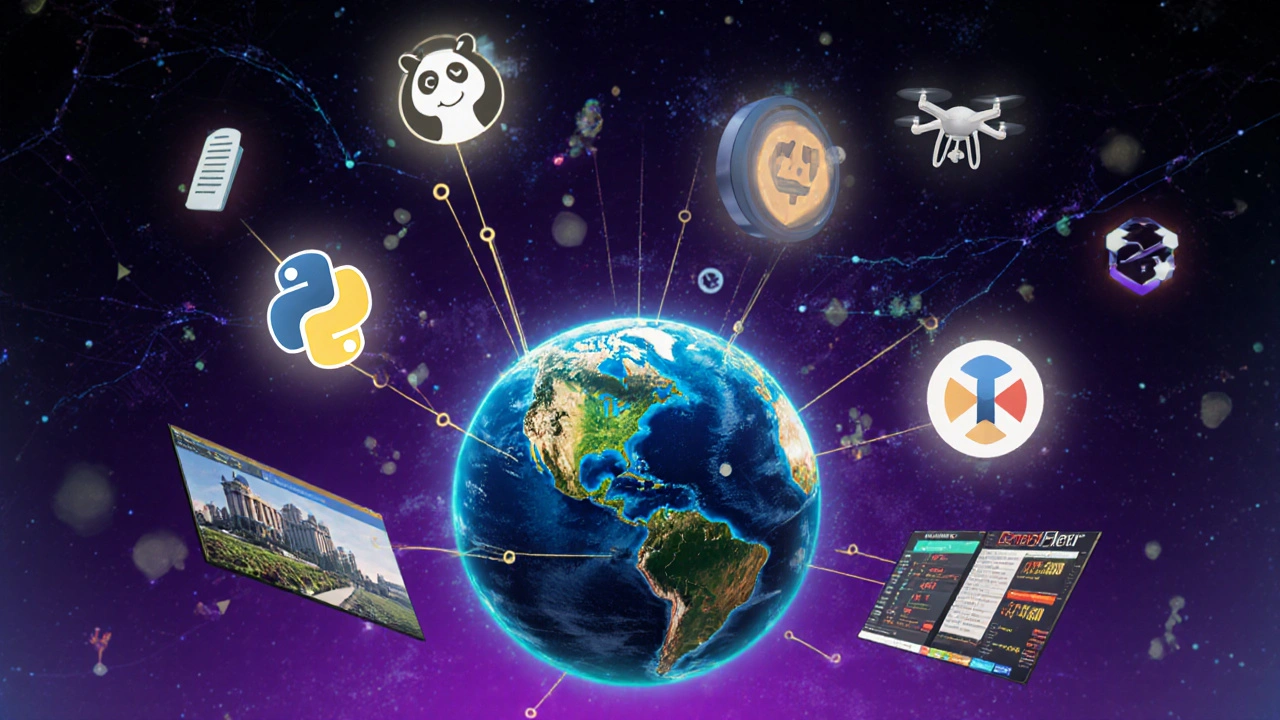AI Development Language Comparison Calculator
Python dominates AI development because it allows for rapid prototyping and experimentation. This calculator shows how Python compares to other languages in terms of development time, cost, and implementation ease for your AI project.
Key Insight: Python lets you test 50 ideas in the time it takes to compile one in Java. While Python is slower for raw computation, its ecosystem and community make it the practical choice for most AI projects.
By 2025, over 90% of new AI projects are built with Python. That’s not a coincidence. It’s the result of a decade-long shift where Python became the default language for building intelligent systems-from chatbots that answer customer service questions to algorithms that predict medical outcomes. If you’re wondering why Python dominates AI, the answer isn’t about being the fastest or the most powerful. It’s about accessibility, ecosystem, and momentum.
Python’s Rise Wasn’t Accidental
In the early 2010s, AI was mostly confined to research labs. Universities used MATLAB or C++ because they were fast. But real-world AI needed something else: libraries that could handle data, not just math. Python had those. Libraries like NumPy and SciPy let researchers manipulate arrays and run statistical models without writing hundreds of lines of code. Then came scikit-learn in 2010, which turned machine learning from a theoretical exercise into something engineers could actually use.
By 2015, TensorFlow and PyTorch arrived. These weren’t just tools-they were ecosystems. TensorFlow, created by Google, gave developers a way to build neural networks that scaled from laptops to data centers. PyTorch, from Facebook, made debugging and experimenting with models feel like writing regular Python. Suddenly, a grad student with a laptop could train a model that recognized cats in images. A startup could build a recommendation engine without hiring a team of C++ engineers.
The Libraries That Changed Everything
Python doesn’t win because it’s the best programming language. It wins because it has the most complete toolkit for AI.
- NumPy handles numerical data with speed close to C-essential for processing millions of data points.
- Pandas lets you clean messy real-world data-like customer records with missing fields or timestamps in five different formats.
- scikit-learn provides ready-made algorithms for classification, clustering, and regression. Need a random forest? Two lines of code.
- TensorFlow and PyTorch are the two dominant deep learning frameworks. PyTorch is now preferred in research; TensorFlow still leads in production deployments.
- OpenCV powers computer vision tasks like facial recognition and object tracking in videos.
- Hugging Face isn’t a library-it’s a platform. But its Python API lets you download, fine-tune, and deploy state-of-the-art language models like Llama or GPT with a single function call.
These tools don’t just make coding easier. They lower the barrier to entry. A marketing analyst with no formal computer science training can now build a model that predicts which customers will churn. A small clinic can use Python to analyze X-rays without buying expensive proprietary software.
Real-World Impact Across Industries
It’s not just tech companies using Python for AI. It’s hospitals, farms, banks, and governments.
In healthcare, hospitals in the U.S. and Europe use Python-based models to predict sepsis 12-24 hours before it happens. These models analyze vital signs from ICU monitors in real time. The system flags at-risk patients before symptoms become obvious. That’s not science fiction-it’s running in over 200 hospitals today.
On farms, companies like John Deere use Python to process satellite and drone imagery. Algorithms detect crop stress, nutrient deficiencies, and pest outbreaks. Farmers get alerts on their phones telling them exactly which fields need attention. That cuts fertilizer use by up to 30% and boosts yields.
Banking is another example. JPMorgan’s COiN platform uses Python to review commercial loan agreements. What used to take 360,000 hours of human labor annually now takes seconds. The model doesn’t replace lawyers-it flags clauses that need review, letting humans focus on judgment, not reading.
Even public transit systems use Python. In London, AI models predict subway delays based on weather, events, and historical data. The system adjusts train schedules in real time and sends alerts to commuters. That’s not a luxury-it’s a necessity for a city of 9 million people.

Why Not Other Languages?
You might wonder: why not Java? Or C#? Or Rust? They’re faster. More secure. Better for large-scale systems.
Here’s the catch: speed doesn’t matter if you can’t build the model in the first place. Most AI development isn’t about optimizing performance-it’s about experimentation. How many iterations can you run in a week? Python lets you test 50 ideas in the time it takes to compile one in Java.
Also, talent matters. There are over 10 million Python developers worldwide. How many know how to write CUDA kernels for C++ AI systems? Maybe 50,000. Companies don’t hire AI engineers because they’re experts in low-level code. They hire them because they can prototype fast, communicate with data scientists, and deploy models without a Ph.D.
Even Google, which built TensorFlow, encourages Python over C++ for most AI work. Their own internal guidelines say: “Use Python unless you’re pushing the limits of hardware.”
The Hidden Costs of Python
Python isn’t perfect. It’s slow. A single loop in Python can be 10-100 times slower than C++. For production systems that handle millions of requests per second, that’s a problem.
That’s why companies use Python for development, then optimize later. They rewrite performance-critical parts in C++, Cython, or Rust. Or they use tools like Numba to compile Python code to machine instructions on the fly. Or they offload heavy computations to GPUs using CUDA through PyTorch.
Most AI teams don’t run Python in production. They export trained models to formats like ONNX or TensorFlow Lite and deploy them on specialized hardware. Python is the design studio. The factory runs on something else. But without Python, the design wouldn’t exist.

What’s Next for Python in AI?
Python’s dominance isn’t guaranteed forever. New languages like Julia promise faster execution and better math support. But adoption is slow. The ecosystem around Python is too big to replace quickly.
What’s changing now is how Python is used. The focus is shifting from training models to managing them. Tools like MLflow and Weights & Biases help teams track experiments, version datasets, and deploy models reliably. Kubernetes and Docker are now standard for running Python-based AI services at scale.
Another trend: smaller models. Instead of training massive models like GPT-4, companies are fine-tuning lightweight models on their own data. Python makes this easy. Hugging Face’s transformers library lets you download a 7-billion-parameter model, train it on 10,000 customer emails, and deploy it on a $50 cloud server. That’s something you couldn’t do five years ago.
Python is also becoming more accessible. Platforms like Google Colab and Kaggle give anyone with a browser free access to GPUs and datasets. Students in Nairobi, farmers in Kenya, and hobbyists in rural India are building AI tools today using nothing but Python and a Wi-Fi connection.
How to Get Started
If you want to join this wave, you don’t need a degree in computer science. Start here:
- Install Python (version 3.10 or higher).
- Learn the basics: variables, loops, functions.
- Install Jupyter Notebook-it lets you write code and see results side by side.
- Use scikit-learn to build your first classifier. Try predicting whether a customer will buy based on age and spending.
- Move to PyTorch. Train a model to recognize handwritten digits using the MNIST dataset.
- Join Hugging Face. Download a pre-trained model and tweak it for your own use case.
You’ll hit walls. You’ll get error messages that make no sense. That’s normal. But every expert started exactly where you are now.
Why is Python the best language for AI development?
Python isn’t the fastest or most efficient language, but it has the most complete ecosystem for AI. It has libraries for every stage of development-data cleaning, model training, deployment-and a huge community that shares code, tutorials, and solutions. Most AI researchers and engineers use Python because it lets them build and test ideas quickly, not because it’s technically superior.
Can I build AI without knowing Python?
You can use no-code platforms like Teachable Machine or Lobe to build simple AI models without writing code. But if you want to customize models, fix errors, or scale your work, you’ll eventually need Python. Most professional AI teams rely on Python for full control over their systems.
Is Python slow for AI applications?
Yes, Python is slower than C++ or Rust for raw computation. But in AI, speed matters less than iteration speed. Developers write models in Python, then optimize only the critical parts-like using GPU-accelerated libraries (PyTorch, TensorFlow) or rewriting bottlenecks in C++. The trade-off is worth it: you can build 10 prototypes in Python before you finish compiling one in C++.
What’s the difference between TensorFlow and PyTorch?
TensorFlow, created by Google, is more focused on production deployment and has strong tools for scaling models across servers. PyTorch, from Meta, is more flexible and easier to debug, making it the favorite in research labs. Most new papers use PyTorch; most deployed systems still use TensorFlow. But the gap is closing-many teams now use both.
Do I need a powerful computer to learn AI with Python?
No. You can start with a basic laptop. Platforms like Google Colab give you free access to GPUs for training models. You only need high-end hardware if you’re training massive models like GPT-4. For learning and small projects, a $50/month cloud instance is enough.
Python didn’t transform AI because it was designed for it. It transformed AI because it was already everywhere-and people made it work. Today, it’s the glue holding together data, models, and real-world applications. If you want to be part of the next wave of AI innovation, Python is still the place to start.

